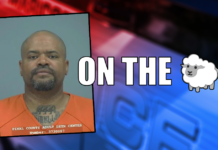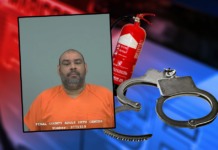
On a recent Sunday afternoon inside Maricopa’s Fire Station 571 on Porter Road, firefighters Jon Sheaffer, Jim Lairmore, Carlos Schulz and Andrew Boland were finishing up a lunch of Subway sandwiches and salads at a long table.
Amid conversation, their eyes wandered to the Arizona Cardinals game playing on the big-screen television. It had been several hours since responding to a call – a typical Sunday lull.
Thirty-four miles away on the top floor of a downtown Phoenix building, a channel one operator warned the four-man crew of a local emergency.
Inside the fire station, an alarm sounded.
The four ran out to the ladder truck housed within the station’s garage, quickly changed into appropriate gear, and hopped in – Lairmore and Schulz in the front, Boland and Sheaffer in the back.
They adjusted their headsets and listened to Capt. Lairmore describe the call: male, 91 years old, vomiting, has a history of heart conditions. Lairmore, seated in the front passenger seat, read the details from an onboard computer.
With Schulz at the wheel, the sirens wailed and cars pulled to the side of the street.
What happens between someone dialing 911 and when police or fire arrive on a scene is complex – a coordinated effort among first responders like those in Maricopa and dispatchers miles away.
And the process of making sure fire or police officials arrive at the correct address begins long before a 911 call is ever made.
Both the Phoenix Regional Dispatch Center, which provides dispatching service for Maricopa Fire Department, and Buckeye’s police dispatch center, which provides services for the Maricopa Police Department, coordinate with Pinal County to guarantee an address is registered before a building or home is even built.
The two centers also use state-of-the-art technology to provide their much-needed, life-saving services.
How it starts
So how exactly do first responders know where to go?
Entering a business or home address in the 911 system that first responders use starts at the county level. Before a building or home is built, developers register an address with Pinal County’s Planning and Development Department.
Global Water, which provides water utilities for Maricopa residents, also provides addresses to the county, said Chief of Police Steve Stahl.
Then, someone from the county’s planning department enters the address in a program called the Geographic Information System. This is the same interface that underlines GPS tools like Garmin.
A software program called Citus Search enters the newly registered address into the 911 dispatch system – CAD, or Computer Aided Dispatch. Within two to five minutes, that information is available to dispatchers.
“They may wonder, ‘Well I just moved into this new home. Does anybody know that I’m here?’ And yes, the first responder community does know very quickly how to dispatch someone to a particular address,” said Heather Murphy, a former spokeswoman for Pinal County.
While Maricopa constantly is developing and Pinal County has been able to keep up with the growth, Stahl said one challenge is making sure the maps are updated quickly.
“That is something we continue to work on,” he said. “The city does not have its own GIS mapper. It’s an expensive position to fill, so we’re relying on partners like Pinal County and Global Water with GIS mapping and making sure that the addresses are correct.”
Phoenix Fire Department Regional Dispatch Center
The Phoenix Fire Department Regional Dispatch Center, which provides dispatching services for 27 jurisdictions including Maricopa, has been recognized for its advanced dispatcher training, technology and facilities. People from around the world regularly tour the facility to learn about how the center works, including recently, representatives from Singapore, Canada, Japan and Thailand.
Providing great customer service and saving lives starts with advanced training, said Danny Wilson, the deployment communications supervisor at the dispatch center.
“This sets us apart from other people,” he said. “The amount of training we do here and the quality of training. Like I said, it’s unparalleled.”
The National Fire Protection Association requires all dispatchers meet certain results before they work on their own. For example, dispatchers are expected to get calls dispatched in 90 seconds or less 90 percent of the time, Wilson said.
The training at the Phoenix center is even more rigorous than training at other facilities, Wilson said. Aspiring dispatchers spend six months training with the help of a supervisor before they begin dispatching calls on their own. In training, they use a stimulated CAD system and practice using real-life scenarios. In many other facilities, Wilson said, dispatchers train using pen and paper instead of a computer system.
“I’ve worked other places, and I’ve always worked alongside good people, but we’re well trained here, well equipped. This is a great place to be. If I call 911, this is where I want it to go.”
That training – and the intuition of one dispatcher – recently saves one Maricopa resident’s life, said MFD spokesman and paramedic Brad Pitassi.
“We were dispatched to a difficulty breathing call. It’s what it started off as,” said Capt. Lairmore, who was on the call with Pitassi.
While firefighters were responding, the dispatcher asked the woman a series of questions, and realized she was on new medication and having an allergic reaction.
Having that information changed how firefighters and paramedics provided care once they arrived.
“Having all this information, so when we found her unresponsive and not breathing, allowed the paramedics to know it’s not a cardiac event. It’s a anaphylactic shock type of event,” Lairmore said. “We gave her the right medication faster, and ultimately that’s what saved her.”
If firefighters hadn’t received that information, they would have tried other alternatives first, Pitassi said.
“We would have thought along a different track. We would have to take time to put an electric monitor on to see what activity was going on in her heart,” he said.
“Our ability to make those decisions, in this case, really relied on the quick thinking and the professionalism and the training from that dispatcher,” Pitassi added.
How it works
When you call 911, a police or Department of Public Safety operator initially picks up the call, depending on where you’re calling from.
“The operator is different than the dispatcher. The operator’s sole purpose is to answer the phone and elicit information from the caller that is pertinent to the officer responding,” Stahl said.
If you’re calling with a police emergency, the call will be transferred to a police dispatcher. If you’re calling with a fire or medical emergency, it is transferred to a fire dispatcher. The transfer takes less than a few seconds.
“The dispatcher then prioritizes that based on the urgency and time constraints of getting law enforcement or public safety there,” Stahl said.
At this point, the process begins to differ if you’re calling with a fire emergency.
During a fire emergency, someone called a channel one operator, who oversees all the calls, sets off the alarm in the fire station and alerts first responders as to what type of emergency they are responding to.
After the channel one operator dispatches the units, someone called a tactical radio operator – TRO for short – takes over the call. The operator informs first responders of any changes in a person’s status, or any clues that could help them navigate to the location.
“The TRO’s job is to monitor the unit from the time they hit the road to the time they clear,” Wilson said.
***ADVERTISEMENT***Problems
Running such an extensive operation can have its problems, Wilson said.
“There’s always kind of a hidden cost of running an operation like this. … but running the CAD system (is expensive),” he said. “There are laws that say how long you have to keep information, for example.”
Wilson said he did not know exactly how much it costs to run the dispatch center, but he said it’s a multi-million dollar operation. Stahl also said that running the police dispatch center was expensive.
MPD used to receive dispatching services through Pinal County, but switched over to Buckeye recently.
Police officers used to have problems receiving radio reception in certain areas of the city, like the Tortosa community, Stahl said.
“There were a great deal of dead spots in the city where the officers received no radio frequency whatsoever,” Stahl said. “There are stories of officers standing on top of their car holding their hand up in the air to receive reception.”
The police department decided to start contracting with the Buckeye dispatch center because their system used 800-megahertz equipment and could provide better radio reception for officers, Stahl said.
Since then, reception has been much better, Stahl said.
The human element
The system is quick and effective, but there are still some issues facing 911 dispatch operators – the “human element.”
If someone pronounces a road name incorrectly, doesn’t know how to spell a road name or has a very thick accent, it can lead to a delay, said former Pinal County spokeswoman Heather Murphy. But Maricopa residents don’t have to worry.
“The 911 system and the operators have so much training in how to handle those situations that very quickly they’re able to resolve that kind of confusion,” she said.
Jonathan Jacobs, a Phoenix Fire Department spokesman, said sometimes an address will not show up in the system, but dispatchers, firefighters and paramedics know how to handle the situation.
The tactical radio operator will give first responders an approximate address, or will tell them to look for certain landmarks.
“They’ll communicate with that fire truck,” Jacobs said. “They give you updates (like) ‘Hey, you need to go around the back. Come around the backside. They’re going to open the back gate for you.’”
Jon Sheaffer, another MFD spokesman, said Maricopa firefighters also do a lot of area familiarization to guarantee they can get to an address during an emergency.
“We do a lot of driving around to make sure we’re familiar with (roadways and neighborhoods),” he said.
And Ricky Alvarado, MPD spokesman, said officers know the neighborhoods they cover from patrolling and working a certain beat.
For example, “we know there’s no 10,000 block,” he said.
Sheaffer said the dispatch system can locate a person’s whereabouts depending on what type of phone they call from.
If a person calls from a landline, the address automatically pops up onto the dispatcher’s computer. If a person calls from a cellphone, GPS coordinates are displayed. And if the GPS is turned off – as is often the case in older cell phones – the CAD system is able to locate the caller within a certain radius provided by cellphone towers.
Sometimes a person calling 911 won’t know where they are, but the CAD system still can locate a person within a certain radius, depending on the type of phone they’re calling from.
For example, if the person is in a remote area hiking or horseback riding and the coordinates provided by the phone are not specific, the dispatcher will ask for the closest cross streets, the trail name or other landmarks.
Five minutes
On that Sunday afternoon, a woman anxiously waited outside the Rancho El Dorado home as the ladder truck pulled up in the middle of the road. The four firefighters hopped off the truck, ready to provide care to the 91-year-old male.
They grabbed some medical equipment and bustled into the home, closing the door behind them.
It’s a complicated system – with many agencies, departments, people, equipment and technologies involved. But despite the complexity, it remains a virtually seamless process for those calling 911, officials said.
Firemen try to respond to the scene of an emergency within five minutes, Pitassi said.
On that Sunday, it took three minutes and 33 seconds.
All that, in three minutes and 33 seconds.










![Maricopa restaurateur makes Food Network connection [Namkeen Dhaba]](https://www.inmaricopa.com/wp-content/uploads/2024/04/439456716_377105198650519_7536248579664805896_n-218x150.jpg)
![Merging lanes incite more 347 anger A merging lane sign sits on the side of State Route 347 northbound lanes during evening traffic on April 30, 2024. [Monica D. Spencer]](https://www.inmaricopa.com/wp-content/uploads/2024/04/spencer-043024-adot-merging-lanes-347-web-218x150.jpg)




